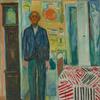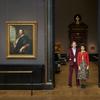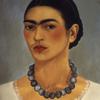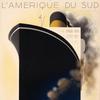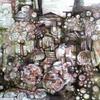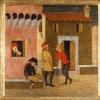Minneapolis Institute of Art Acquires Nearly 800 Works on Paper by Theodore Roszak
- MINNEAPOLIS, Minnesota
- /
- July 01, 2021
The Minneapolis Institute of Art (Mia) has announced the acquisition of nearly 800 works on paper by the Polish-American artist Theodore Roszak (1907–1981). The works—including 727 drawings, 63 prints, and three photographs—were given by the artist’s daughter, Sara Roszak, on behalf of the artist’s estate; Michael Rosenfeld Gallery facilitated the gift. Today
best known for his sculptural work, Roszak experimented with various techniques across a wide range of styles, notably creating abstract geometric forms, influenced by technology, in wood, plastic, and metal. The gifts to Mia, created between 1920 and 1980, represent the numerous themes, subjects, and styles the artist explored throughout his prolific career. The newly acquired works complement and enhance Mia’s collection of modernist art.
Robert Cozzolino, Mia’s Patrick and Aimee Butler Curator of Paintings, worked closely with Sara Roszak on the selection of materials for the museum. Cozzolino, who specializes in American modernism, has long admired Roszak’s work.
“This generous gift will help Mia to tell a more dynamic story of modernist drawing and sculpture in the United States, especially because Roszak was a tireless innovator, open to new forms and techniques,” Cozzolino said. “Even though his approach and philosophy overlapped with styles ranging from constructivism and abstract expressionism to surrealism and realism, he always remained an independent.”
He continued: “We are very excited to study and display Roszak’s works in dialogue with those by his contemporaries in our collection, including Alberto Giacometti, Henry Moore, George Rickey, and Louise Nevelson. I am particularly interested in showing his late political and satirical drawings with works by a much younger generation. It is an important part of his career that is not well known.”
Tom Rassieur, the John E. Andrus III Curator of Prints and Drawings, added: “It is an honor for Mia to have been entrusted with this gift. We aim for depth and quality in our collection, and the Roszak gift brings an ample slice from the career of an artist whose work I've long admired. We are truly grateful to Sara Roszak Born in Poland in 1907, Theodore Roszak emigrated to the United States when he was 2 years old. He studied and worked at the School of the Art Institute of Chicago (SAIC) before moving to New York City, where he worked for the Works Progress Administration (WPA). In addition to being featured in several solo exhibitions at commercial galleries and museums during his lifetime, Roszak’s work was included in many group shows, including the first Whitney Biennial in 1932. Roszak accepted numerous public commissions across the United States, most notably the Bell Tower for the Chapel at the Massachusetts Institute of Technology (MIT) in Cambridge (1956), and a sculpture for the courtyard of the Bellevue Hospital in New York City, commissioned by the City of New York (1968). Roszak taught at Sarah Lawrence College for 16 years.
More than simply the study collection for a single artist, the depth, breadth, and quality of the gifts will greatly enhance Mia’s ability to represent modernist drawing and developments in modernist sculpture. Roszak often experimented with ideas on paper before pursuing them in three dimension; these sketches stand alone as works of art. Before now, Mia did not have any works by Roszak in its collection, although several works have been on long-term loan as part of the Myron Kunin Collection. Related drawings for some Kunin Collection works are part of the gift, and Cozzolino looks forward to organizing an exhibition to present these works together.
Highlights of gifts to Mia include:
• Sammy, 1933, ink on paper
A gorgeous example of early portraiture and observational drawing.
• Untitled, 1936, ink and brush on paper
An early abstract work that pushes the limits of form, developed parallel to international
movements.
• The Furies of Folly Cove, 1952, black and sepia ink and wash on paper
Roszak is perhaps best known for explosive, virtuoso organic drawings made in the 1950s and
1960s; here is an excellent example.
• Urban Construction (sculpture study), 1950s, pen on paper
Roszak was open to any process that might lead him to new ways of thinking about form;
working on paper was critical to that. Here is an improvisatory ink drawing that likely led to some
tangible 3-D form.
• The Last Tycoon (Gulliver), 1976, graphite and colored pencil
Little known in Roszak’s output are his surrealist satirical and political drawings of the 1970s,
involving class critique, anti-war sentiment, and the skewering of politicians.
Sara Roszak noted: “We are thrilled that [Mia’s] Collections Committee has unanimously accepted and accessioned our gift of a significant and extensive selection of drawings from the Estate of Theodore Roszak. This gift will complement and give additional depth to the collection of my father’s work already at Mia, and we hope will bring delight and challenge the imagination of your audience.
“My father started drawing at the kitchen table as a little boy, and he drew every day for several hours until the day he died. It was his overriding passion and a fascinating window into his aesthetic, intellectual, and emotional life. It follows many roads with humor, humility, and compassion and for the human condition. It was a most personal conversation with himself. Bringing this work into the public domain has also taken years for us to organize, inventory, and catalogue. We are excited for the new scholarship to come and insight into his unique sensibility.”

